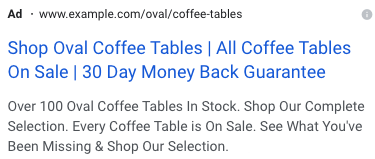Google Ads has implemented many changes this year. Most involve more automation. Google has streamlined the setup for how keyword match types trigger ads. Responsive search ads will soon be the default ad type, and refinements to bid strategies continue. The impact of these changes means advertisers may need to restructure their search campaigns.
However, the fundamentals of paid search will always apply. They are:
- Create tightly themed campaigns and ad groups. For example, a campaign for coffee tables should have ad groups focused on oval coffee tables, round coffee tables, square coffee tables, and similar.
- Ad groups should contain only variations of the core keyword. An ad group for oval coffee tables could have keywords such as “oval coffee tables,” “brown oval coffee tables,” and “coffee tables in an oval shape.”
- Every ad in every ad group should contain the targeted keyword. Users who search for “oval coffee tables” should see this keyword or a variation in the ad.
Using those fundamentals, here’s how to structure your paid search campaigns in late 2021.
Match Types
Modified broad match used to be a staple for advertisers, who could easily add a single keyword instance that would show for many variations. A plus sign in front of each term would tell Google that an ad should show if the query had all the words no matter the order. For example, the modified broad match of “+oval +coffee +tables” would trigger ads for these queries:
- “small oval coffee tables,”
- “coffee tables that are oval,”
- “coffee tables oval.”
As of July 2021, advertisers cannot add modified broad match keywords. Instead, phrase match will include modified broad match features. Google claims that phrase match will now show ads from the same queries as modified broad match unless the word order changes the meaning.
Thus new ad groups should utilize exact and phrase match. Broad match is helpful for longer tailed or specific queries. Modified broad match keywords will still serve ads but with phrase match behavior.
In short, transition modified broad match keywords to phrase match.
Responsive Search Ads
RSAs launched in 2018. The format allows advertisers to include up to 15 headlines and four description lines that Google will automatically rotate and optimize based on your conversion or bid strategy goal. Most advertisers already have an RSA in every ad group. but as of June 30, 2022, creating expanded text ads (ETAs) will not be an option, although legacy ETAs can still run.
Advertisers should create new ad groups only with RSAs. There is no need to use ETAs. Advertisers can pin the assets to force the three headlines and two description lines to show in exact order. For example, here are three pinned headlines in the Google Ads interface.
—
And here is an example ad with those headlines.
The downside to using just three headlines and two description lines is that Google could classify the ad strength as poor, potentially leading to fewer impressions. With RSAs, always strive to include all 15 headlines and four description lines. Pin headline 1 or 2 to ensure that the targeted keyword always shows.
Advertisers who have not created RSAs should apply components of their top-performing ETAs. For example, use the messaging of the highest-converting ETA for the new RSA.
Smart Bidding
Advertisers should use smart bidding unless there is a reason to avoid automation, such as ensuring the average cost-per-click never exceeds a certain amount. Smart bidding through automated bid strategies optimizes around a specific goal. For example, a goal of increasing conversions can apply a “maximize conversions” bid strategy with the option of setting a target CPA.
Automated bidding is powerful because it factors many auction-time signals to determine the bid, such as the searcher’s operating system and search history. Many of these signals are unavailable to manual bidders.
Determine your goal — conversions, revenue, clicks — before adopting a bid strategy. Review data in individual campaigns from the previous 30 to 60 days to set the strategy. The more data, the better.
If the goal is to maximize revenue with a target return on ad spend, find the historical ROAS. If it’s 400%, start with this threshold. Launch with whatever ROAS is necessary for a specific product type to be profitable. Adjust the goal later as needed.






